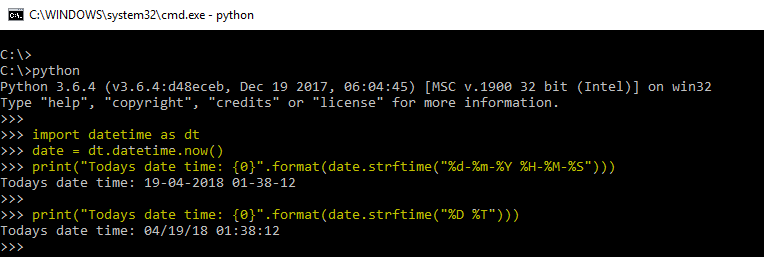

To do this, you need to create a timedelta object with all the time components using the arguments. Now we will see hot to add or subtract a time object with all the time components with a datetime object.
DATETIME.NOW MINUS MINUTES PYTHON HOW TO
So far, we have seen how to add and subtract individual time component like hours or minutes or seconds from a datetime object. it's simple example of how to subtract minute to current date in python. Im going to show you about how to subtract minutes to date in python. Print("After subtracting microseconds: ", datetime_new, "\n")Īdding and subtracting datetime object with time object Now, let's see article of python subtract minutes to datetime example. Print("After subtracting seconds: ", datetime_new, "\n")ĭatetime_new = datetime_new - timedelta(microseconds = microseconds_to_add) Print("After subtracting minutes: ", datetime_new, "\n")ĭatetime_new = datetime_new - timedelta(seconds = seconds_to_add)
DATETIME.NOW MINUS MINUTES PYTHON CODE
date (2022,3,27) print( date1) Output: Copy You can try the code on the Geekflare Python compiler to test. Here’s an example of creating a date object date1: from datetime import date date1 datetime.
Print("After subtracting hours: ", datetime_new, "\n")ĭatetime_new = datetime_new - timedelta(minutes = minutes_to_add) To create a date object in Python, you can use the general syntax datetime.date (# Subtracting hours or minutes or seconds to datetimeĭatetime_new = datetime_original - timedelta(hours = hours_to_add) Then you can as that object for min, seconds and milliseconds, bu using the sub function of the class. To perform subtraction of individual time components from datetme object, just create a timedelta object with the time component and then subtract from the datetime object.

Print("After adding microseconds: ", datetime_new, "\n")

We can give either integer or float values to these arguments. It returns a timedetlta object datetime.timedelta(days0, seconds0, microseconds0, milliseconds0, minutes 0, hours 0, weeks 0) All seven arguments are optional, and the default value is 0. Print("After adding seconds: ", datetime_new, "\n")ĭatetime_new = datetime_new + timedelta(microseconds = microseconds_to_add) Create a timedelta object in Python using the following method. Print("After adding minutes: ", datetime_new, "\n")ĭatetime_new = datetime_new + timedelta(seconds = seconds_to_add) set datetime.today () to a variable and replace with d.replace (hour1, minute50) then subtract time asfarto at 11:22 Add a comment 14 This worked for me : from datetime import datetime s1 '10:04:00' s2 '11:03:11' for example format 'H:M:S' time datetime.strptime (s2, format) - datetime. Print("After adding hours: ", datetime_new, "\n")ĭatetime_new = datetime_new + timedelta(minutes = minutes_to_add) Print("\nOriginal date: ", datetime_original, "\n")ĭatetime_new = datetime_original + timedelta(hours = hours_to_add) # Adding hours or minutes or seconds to datetimeĭatetime_original = datetime(year=2006, month=11, day=23) Example 2: Python Subtract Minutes to Current DateTime main.py from datetime import datetime from dateutil.relativedelta import relativedelta myDate datetime.


 0 kommentar(er)
0 kommentar(er)
